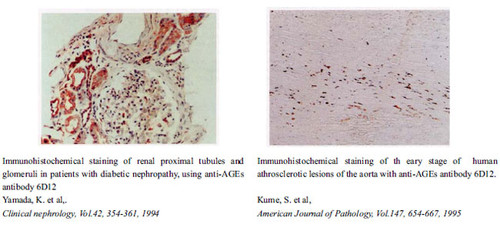| Citations for Anti AGEs mAb (Clone 6D12) – 7 Found |
| Moschonas, Dimitrios P; Piperi, Christina; Korkolopoulou, Penelope; Levidou, Georgia; Kavantzas, Nikolaos; Trigka, Eleni-Andriana; Vlachos, Ioannis; Arapostathi, Christina; Perrea, Despina; Mitropoulos, Dionysios; Diamanti-Kandarakis, Evanthia; Papavassiliou, Athanasios G. Impact of diet-induced obesity in male mouse reproductive system: The role of advanced glycation end product-receptor for advanced glycation end product axis. Experimental Biology And Medicine (Maywood, N.j.). 2014;239(8):937-947. PubMed |
| Baba, Shahid P; Barski, Oleg A; Ahmed, Yonis; O'Toole, Timothy E; Conklin, Daniel J; Bhatnagar, Aruni; Srivastava, Sanjay. Reductive metabolism of AGE precursors: a metabolic route for preventing AGE accumulation in cardiovascular tissue. Diabetes. 2009;58(11):2486-97. PubMed |
| Cabreiro, Filipe; Ackerman, Daniel; Doonan, Ryan; Araiz, Caroline; Back, Patricia; Papp, Diana; Braeckman, Bart P; Gems, David. Increased life span from overexpression of superoxide dismutase in Caenorhabditis elegans is not caused by decreased oxidative damage. Free Radical Biology & Medicine. 2011;51(8):1575-82. PubMed |
| Baba, Shahid P; Hellmann, Jason; Srivastava, Sanjay; Bhatnagar, Aruni. Aldose reductase (AKR1B3) regulates the accumulation of advanced glycosylation end products (AGEs) and the expression of AGE receptor (RAGE). Chemico-Biological Interactions. 2011;191(1-3):357-63. PubMed |
| Wu, Lian; Ma, Li; Nicholson, Louise F B; Black, Peter N. Advanced glycation end products and its receptor (RAGE) are increased in patients with COPD. Respiratory Medicine. 2011;105(3):329-36. PubMed |
| Tsakiri, Eleni N; Sykiotis, Gerasimos P; Papassideri, Issidora S; Gorgoulis, Vassilis G; Bohmann, Dirk; Trougakos, Ioannis P. Differential regulation of proteasome functionality in reproductive vs. somatic tissues of Drosophila during aging or oxidative stress. Faseb Journal : Official Publication Of The Federation Of American Societies For Experimental Biology. 2013;27(6):2407-20. PubMed |
| Kim, Chan-Sik; Kim, Junghyun; Kim, Young Sook; Jo, Kyuhyung; Lee, Yun Mi; Jung, Dong Ho; Lee, Ik Soo; Kim, Joo-Hwan; Kim, Jin Sook. Improvement in Diabetic Retinopathy through Protection against Retinal Apoptosis in Spontaneously Diabetic Torii Rats Mediated by Ethanol Extract of Osteomeles schwerinae C.K. Schneid. Nutrients. 2019;11(3) PubMed |


